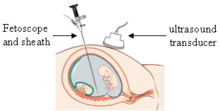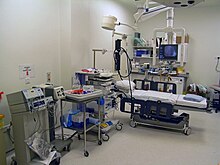Endoscope
An endoscope is an inspection instrument composed of image sensor, optical lens, light source and mechanical device, which is used to look deep into the body by way of openings such as the mouth or anus.
A typical endoscope applies several modern technologies including optics, ergonomics, precision mechanics, electronics, and software engineering.
An endoscope uses tubes only a few millimeters thick to transfer illumination in one direction and high-resolution video in the other, allowing minimally invasive surgeries.
Examples include the cystoscope (bladder), nephroscope (kidney), bronchoscope (bronchus), arthroscope (joints) and colonoscope (colon), and laparoscope (abdomen or pelvis).
[3] The first endoscope was developed in 1806 by German physician Philipp Bozzini with his introduction of a "Lichtleiter" (light conductor) "for the examinations of the canals and cavities of the human body".
The first such lights were external although sufficiently capable of illumination to allow cystoscopy, hysteroscopy and sigmoidoscopy as well as examination of the nasal (and later thoracic) cavities as was being performed routinely in human patients by Sir Francis Cruise (using his own commercially available endoscope) by 1865 in the Mater Misericordiae Hospital in Dublin, Ireland.
[18] Earlier in the 1950s Harold Hopkins had designed a "fibroscope" consisting of a bundle of flexible glass fibres able to coherently transmit an image.
Alongside the advances to the optics, the ability to 'steer' the tip was developed, as well as innovations in remotely operated surgical instruments contained within the body of the endoscope itself.
[citation needed] The tiny lenses of a conventional system required supporting rings that would obscure the bulk of the lens' area.
With the appropriate curvature and coatings to the rod ends and optimal choices of glass-types, all calculated and specified by Hopkins, the image quality was transformed even with tubes of only 1mm in diameter.
A typical endoscope is composed of following parts: Besides, patients undergoing endoscopy procedure may be offered sedation in order to avoid discomfort.
Endoscopes may be used to investigate symptoms in the digestive system including nausea, vomiting, abdominal pain, difficulty swallowing, and gastrointestinal bleeding.
If internal visual inspection of pipes, boilers, cylinders, motors, reactors, heat exchangers, turbines, and other products with narrow, inaccessible cavities and/or channels is to be performed, then the endoscope is an important, if not an indispensable instrument.









